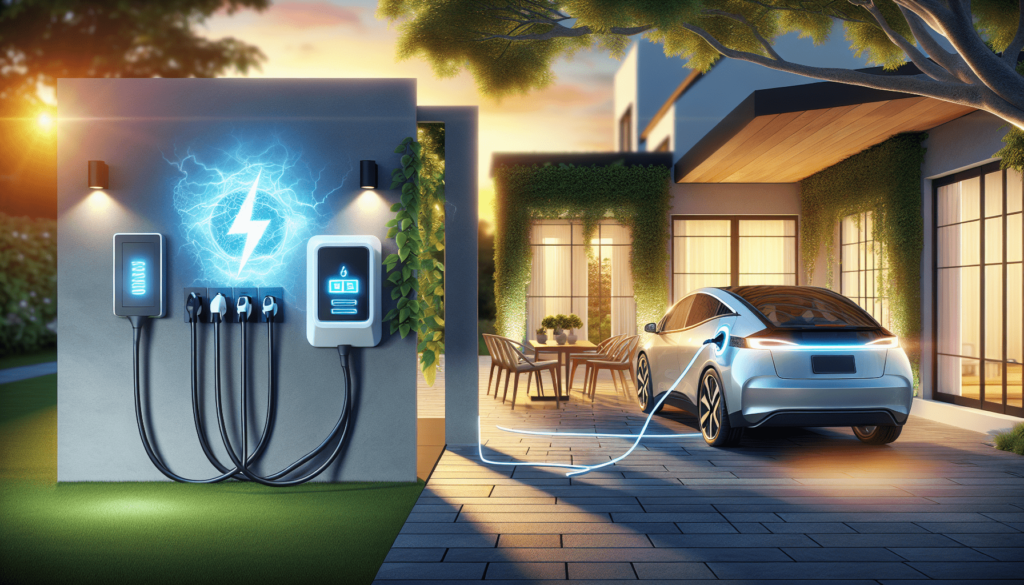Can I charge my EV at home?
Share

So you’ve decided to make the switch to an electric vehicle (EV), but you’re wondering if you can charge it conveniently at home. Well, the good news is that charging your EV at home is not only possible but also incredibly convenient. With the proper equipment, you can easily set up a home charging station that allows you to power up your EV overnight, eliminating the need for frequent trips to public charging stations. Say goodbye to the hassle of searching for available charging spots and hello to the convenience of charging your EV right in your own garage or driveway.
Charging an EV at Home
When it comes to charging your electric vehicle (EV), having the convenience of doing so at home is a game-changer. With the right equipment and setup, you can easily charge your EV overnight and wake up to a full battery each morning. In this article, we will explore the different home charging options available, the requirements for home charging, and how to install a home charging station.
Home Charging Options
There are two main types of home charging options for EVs: Level 1 charging and Level 2 charging. Each option has its own characteristics and considerations, so let’s take a closer look at what they entail.
Level 1 Charging
Level 1 charging is the simplest and most basic way to charge your EV at home. This option involves using a standard 120-volt household electrical outlet and the charging cable that comes with your EV. It provides a charging speed of approximately 2-5 miles of range per hour, depending on the vehicle.
Level 2 Charging
Level 2 charging, on the other hand, offers a faster and more efficient charging experience compared to Level 1. This method requires a dedicated 240-volt charging station that needs to be installed at your home. With a Level 2 charger, you can expect a charging speed of around 10-30 miles of range per hour, depending on your EV’s capabilities.

Level 1 Charging
Level 1 charging may not be the fastest option, but it can still be a viable solution for many EV owners, especially those who don’t have a long daily commute or ample time to charge. Let’s take a closer look at the specifics of Level 1 charging.
Charging Speed
As mentioned earlier, Level 1 charging provides a relatively slow charging speed compared to Level 2. On average, you can expect your EV to gain about 2-5 miles of range per hour of charging. While this may not seem like much, it can still be sufficient for your daily driving needs if you have the time to charge overnight.
Outlet Requirements
To charge your EV using Level 1 charging, all you need is a standard 120-volt household electrical outlet. These outlets can be found in most homes and are the same ones you use for regular household appliances. However, it’s crucial to ensure that the outlet you’re using is dedicated to the EV charger and meets all safety requirements.
Cost
One of the significant advantages of Level 1 charging is its affordability. Since it uses a standard household outlet, you won’t need to invest in any additional equipment or installation. The only cost you’ll incur is the electricity consumed, which will vary depending on your utility rates and the amount of charging you do.
Level 2 Charging
For those who need faster charging speeds and more convenience, Level 2 charging is the way to go. Although it requires additional equipment and installation, the benefits often outweigh the cost involved. Here’s what you need to know about Level 2 charging.
Charging Speed
Level 2 charging offers significantly faster charging speeds compared to Level 1. With a dedicated 240-volt charging station, you can expect to add around 10-30 miles of range per hour of charging, depending on your EV. This means that even with a short charging session, you can acquire a substantial amount of range, making it ideal for regular daily usage.
Installing a Level 2 Charger
To install a Level 2 charging station, you’ll need the help of a certified electrician. They will assess your electrical panel’s capacity and make the necessary upgrades to accommodate the charger. Additionally, a dedicated circuit and proper wiring will be installed to ensure safe and efficient charging. While the installation cost may vary, it’s essential to have a professional handle this task for your peace of mind.
Cost
Compared to Level 1 charging, installing a Level 2 charger does come with an upfront cost. You’ll need to purchase the charging station itself, which can range from a few hundred to over a thousand dollars, depending on the brand and features. Additionally, you’ll have to consider the cost of installation, which depends on the complexity of the electrical work required. However, the faster charging speeds and convenience often make it a worthwhile investment for many EV owners.
Benefits of Home Charging
Charging your EV at home brings numerous benefits that make owning an electric vehicle even more appealing. Let’s explore some of the advantages.
Convenience and Accessibility
Having a home charging station eliminates the need for frequent trips to public charging stations. You can simply plug in your EV at night and wake up to a fully charged battery in the morning. This level of convenience and accessibility is especially valuable for individuals who have busy schedules or live in areas with limited charging infrastructure.
Cost Savings
Charging your EV at home can result in significant cost savings compared to relying solely on public charging stations. In most cases, residential electricity rates are lower than the rates at public charging stations. By taking advantage of off-peak hours and time-of-use plans, you can optimize your charging sessions to minimize costs further. Additionally, you’ll save on the expenses associated with driving a gasoline-powered vehicle, such as fuel and maintenance.
Charge Scheduling
Home charging also allows you to take advantage of charge scheduling features available in many EV models and charging stations. With the ability to program when your vehicle charges, you can maximize energy efficiency and minimize peak demand on the electrical grid. This feature proves especially beneficial for EV owners in regions where time-of-use utility rates are offered, as you can charge during low-cost periods.
Considerations for Home Charging
While home charging provides immense benefits, there are a few considerations to keep in mind before diving in. Here’s what you should consider.
Availability of Charging Infrastructure
Before deciding on home charging, it’s essential to assess the availability of public charging infrastructure in your area. If there are numerous charging stations nearby or along your regular routes, you may rely less on home charging. However, if you live in an area with limited charging options, having a home charging setup becomes even more crucial.
Electrical System Capacity
Installing a Level 2 charger requires an evaluation of your electrical system’s capacity. The charging station draws a significant amount of power, so you’ll need to ensure that your electrical panel can handle the additional load. Consulting with a certified electrician will help you determine if any upgrades or modifications are necessary to accommodate the charger.
Utility Rates
Understanding your utility rates is vital when it comes to home charging. Some regions offer time-of-use or flexible rate plans that allow you to take advantage of lower electricity prices during specific hours. Being knowledgeable about these rates can help you optimize your charging schedule and reduce the overall cost of charging your EV at home.

Charging a Home Rental Property
If you live in a rental property, charging your EV at home may present some unique challenges. However, with proper communication and coordination, it is still possible to set up a charging solution. Here are the steps you can take:
Permission from Landlord or Property Owner
First and foremost, seek permission from your landlord or property owner to install a charging station. Discuss the potential benefits and address any concerns they may have. If they approve, you can proceed with the installation process. It is essential to have written consent to ensure clarity and avoid any disputes in the future.
Installing a Charging Station
Once you have permission, you can proceed with installing a Level 2 charging station, following the same process as in a homeowner scenario. However, since you do not own the property, it is crucial to involve a certified electrician who can ensure that the installation is safe and complies with any regulations or guidelines set by the property owner or management.
Communication with Utilities and Property Management
Before installing the charging station, be sure to inform your utility company and property management about your plans. They may have specific requirements or guidelines that need to be followed. Maintaining open communication with all parties involved will help ensure a smooth process and minimize any potential conflicts.
Conclusion
Charging your EV at home is not only convenient but also offers significant benefits in terms of accessibility, cost savings, and charge scheduling. Whether you opt for Level 1 charging or decide to invest in a Level 2 charging station, the ability to wake up to a fully charged battery each morning will undoubtedly enhance your EV ownership experience. Consider the requirements, installation procedures, and cost implications before making your decision, ensuring that you have the necessary permissions and coordination if you’re in a rental property. With the right setup, you can charge your EV at home hassle-free and enjoy the many advantages of electric driving.











